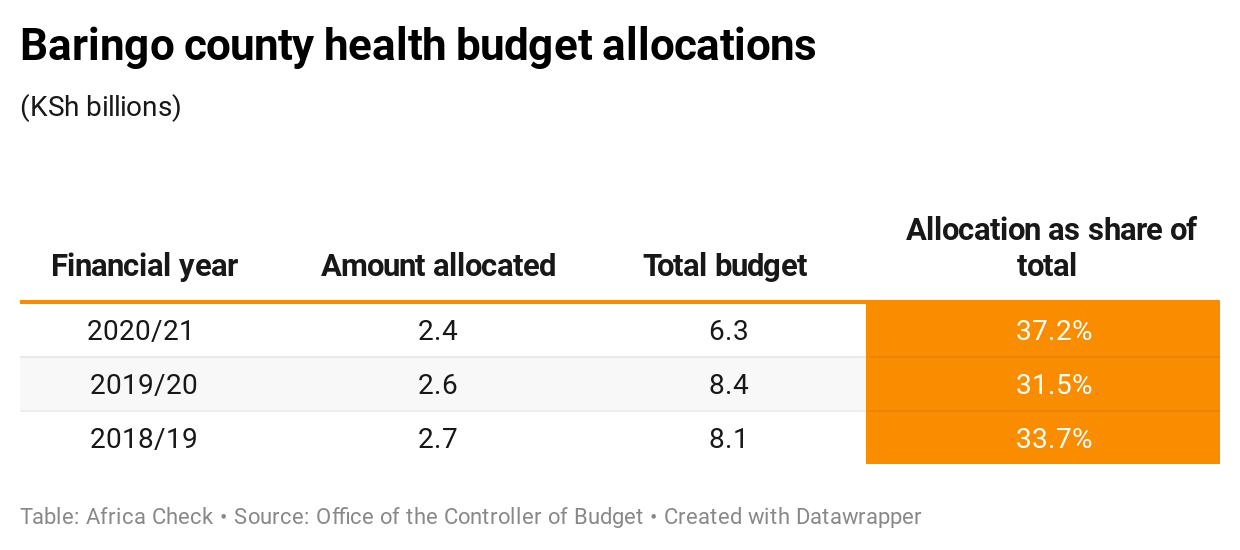- In January 2021 Baringo county governor Stanley Kiptis argued against striking health workers’ pay demands. He made three claims.
- His claim that the county puts 51% of its resources into healthcare is incorrect – it hasn’t been more than 37% in three years. The claim that Baringo’s healthcare allocation is the highest in Kenya is also incorrect.
- But it’s mostly true that Baringo has exceeded the legislated 35% budget cap on staff costs, “at 55.7%”. The county spends 54.7% of its budget on employees.
In December 2020 healthcare workers in Kenya went on strike over issues such as pay and lack of personal protective equipment. The impasse between the workers and their county governor employers continues, crippling the country’s public health sector.
Doctors returned to work in late December, but by early February clinical officers and nurses were still on strike.
The strikes “affect how we work”, Dr Chibanzi Mwachonda, secretary general of the Kenya Medical Practitioners, Pharmacists and Dentists Union, told Africa Check.
Governors insist they don’t have enough money to meet the workers’ pay demands.
As the stand-off raged in January, Baringo County governor Stanley Kiptis claimed that more than half of the county's budget went to health, the highest allocation in the country. He also claimed the county had exceeded constitutional salary limits.
"In Baringo, we put 51% of our resources into healthcare,” he said. “It's the highest. Baringo and some other counties have gone beyond the 35% ceiling as set in the constitution. We are at 55.7%, so we cannot be in a position of, really, meeting those demands.”
But do the governor’s numbers add up? We looked.
The governor’s spokesperson told Africa Check he would confirm the source of this figure. We will update this report with the county’s response.
John Kinuthia from the public finance and budgeting think tank International Budget Partnership-Kenya recommended that we examine allocations to county health departments to check health spending.
All county budgets are submitted to the office of the controller of budget, a state agency that monitors how they are used. Its most recent report, for the 2020/21 financial year, shows that Baringo allocated KSh2.35 billion of a total KSh6.3 billion budget to its health services department.
This works out to 37%. Baringo has not allocated more than this to health in the last three years. We rate the governor’s claim as incorrect.

Kenya has 47 counties. Kinuthia told us there wasn’t any “guidance concerning what constitutes a health ministry or department in a county”.
For example, a “department of health and sanitation” could later change to a “department of health” and a separate “department of sanitation and water”.
In November 2020, when the agency filed its most recent report, 40 counties had allocated their health budgets to a single department, and four had allocated funding to more than one. Three were yet to submit their budgets to the controller.
We compiled the data into a table and calculated the share spent on health ministries.

At least three counties allocated more to health than Baringo: Muranga, Nyeri and Embu. Baringo’s 37.2% health allocation is among the highest in Kenya, but it is not the highest. We rate the governor’s claim as incorrect.
Kenya’s public finance regulations require counties to cap spending on their employees’ wages and benefits at 35% of total revenue.
The controller of budget reports that in 2020 Baringo County allocated KSh3.45 billion for “compensation to employees”. The county’s total expected revenue to finance its budget is KSh6.3 billion.
“Personnel emoluments” – the cost of employee salaries and other benefits – take up 54.7% of the budget.
We therefore rate the claim as mostly correct.
Most health spending goes to pay
For a better understanding of healthcare spending trends in Kenya’s 47 counties, Dr Rahab Mbau, a health economist at the Kenya Medical Research Institute, referred Africa Check to a national health ministry analysis.
This covers spending in the three financial years to 2018/19 and shows that all counties allocated 79% to 82% to recurrent expenditure. Most of these funds were spent on staff costs such as salaries, wages and allowances.
This skew towards staff costs “doesn't make sense”, Dr Chris Masila, founder of Nairobi-based health consultancy Practhealth, told Africa Check.
How much a county spends on health depends on total revenue – and the governor’s vision, Masila said. One year’s figures may not be enough to fully understand health spending, he said, as some objectives take longer.
John Kinuthia from the public finance and budgeting think tank International Budget Partnership-Kenya agreed. “Priorities always go up and down. Just because a county is spending 20% on health does not make it bad. It might be that they have done a lot of health over the last couple of years.”
Photo: Patrick Meinhardt / AFP








Add new comment